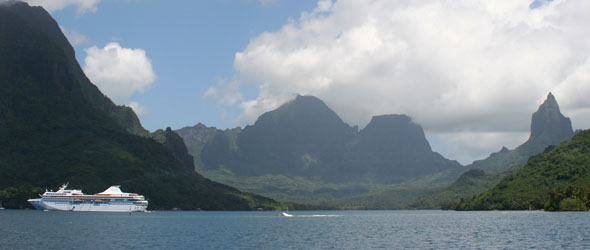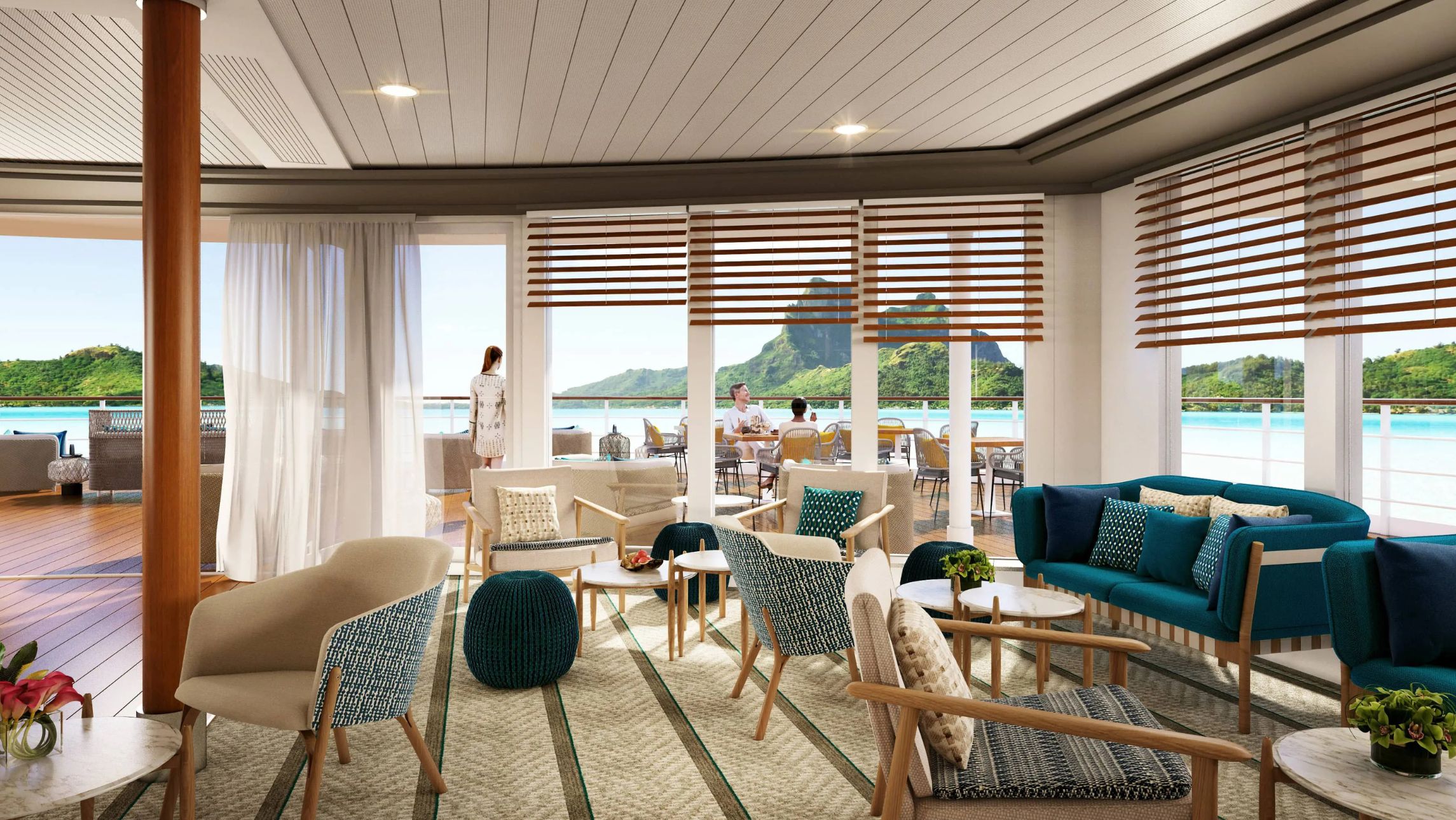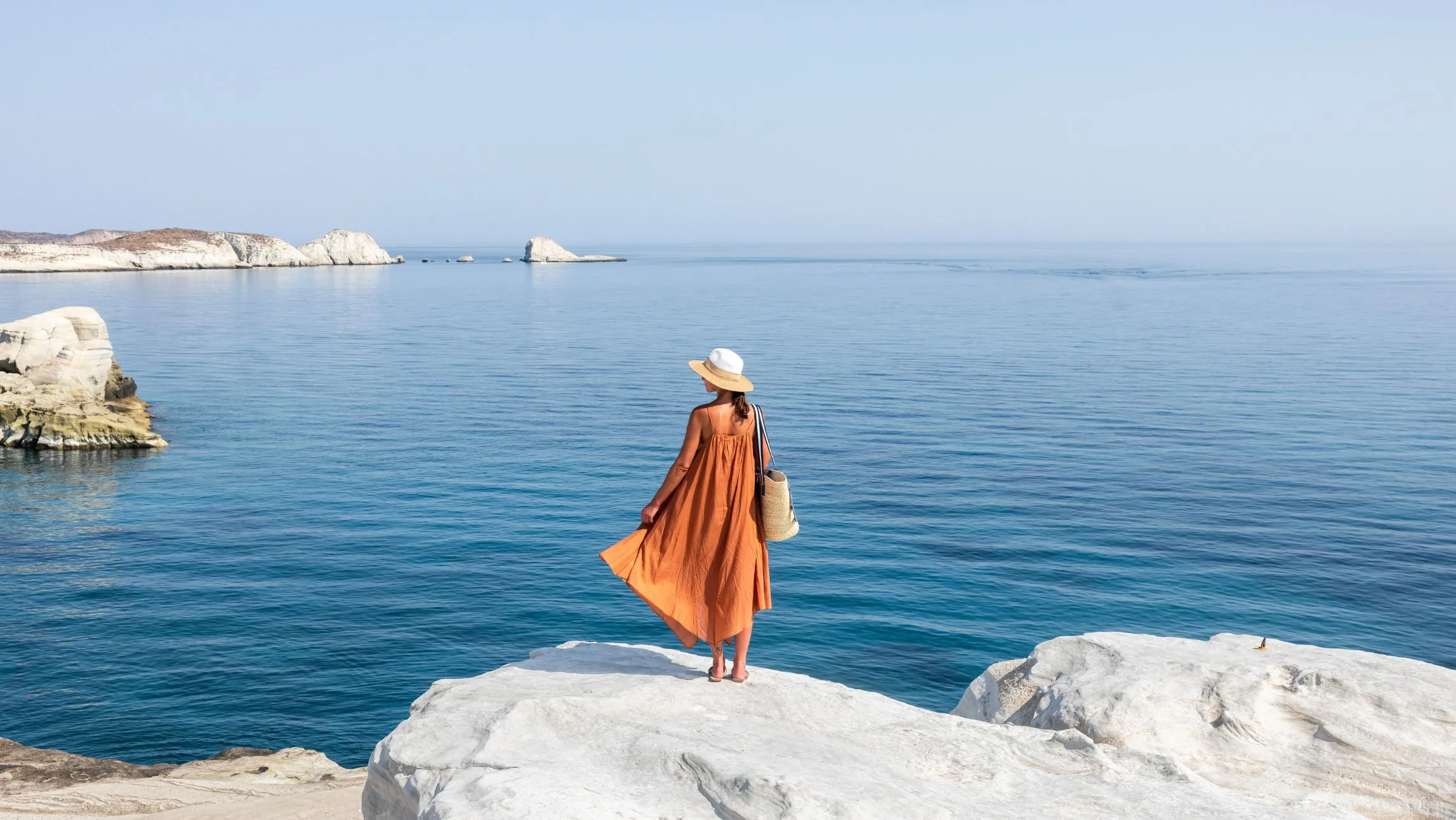It’s just after 6pm and time for the nightly sunset show. We mix a few cocktails in our stateroom suite, and step onto the balcony as the first tinge of yellow permeates the horizon. With the mythical peaks of Bora Bora as the backdrop, the show quickly moves into full swing. From yellow to orange, pink, red, blue, purple – and various outrageous hues in between – the multi-coloured palette moves through the sky and glassy ocean. It’s the end of a typical day in Tahiti, and on a private deck on a six-star cruise ship out in the middle of the ocean it’s hard to believe that somewhere out there is the “real world”.
It’s not surprising that Tahiti attracted the attention of artists like Paul Gauguin. In addition to France’s greatest post-impressionist painter, many other artists, explorers and writers made the arduous journey to French Polynesia, sometimes spending months at sea to answer its alluring call. Today these islands remain picture-postcard perfect: white-sand beaches, turquoise lagoons and jagged mountain peaks. And a leisurely cruise is the best way to experience Tahiti’s seductive highlights. It’s also one of the top places on the planet created for romance.
Aptly named the m/s Paul Gauguin, this 320-guest luxury ship is built specifically to cruise these islands year-round thanks, in part, to a shallow draft which allows her to sail into bays and ports that other vessels can’t access, and most of its itineraries feature a seven-day voyage around the Society Islands taking in Moorea, Bora Bora, Raiatea and Taha’a.
We’d opted for a 14-day cruise which took in the Society Islands, Rangiroa in the Tuamotus and the northernmost archipelago, the Marquesas, which are regarded as one of the most stunningly beautiful island groups in the world. And as with most Gauguin cruises, this one started and finished in Tahiti’s capital city and main port, Papeete, on the main island of Tahiti Nui.
The islands of French Polynesia are stunning and the best way to take in their grandeur is from the water. And as with most Gauguin itineraries, the first stop is the magical island of Bora Bora. As an introduction to Tahiti’s islands, Bora Bora has a “wow” factor that immediately fires the senses – with its emerald-green hills and chameleon-like lagoons, it’s easy to understand why this island is a serious contender for the most beautiful and romantic island in the world.
James Michener, author of Tales of the South Pacific which inspired the movie Bali Hai, wrote of Bora Bora: “Anyone who has ever been there wants to go back.” No doubt Michener himself experienced the fiery sunsets which are unique to this part of the world. After an overnight stop at the coral atoll of Rangiroa in the Tuamotus – famous for its amazing diving – it then was time to experience the highlight of the cruise – the moody and mystical Marquesas.
As our zodiac powers its way towards Omoa Bay, the eerie sounds of conch shells and drums pounding out a driving rhythm increase in intensity. Volcanic cliffs almost one kilometre high drop straight into the ocean which fortunately remains calm enough to allow us entry onto the most remote and unspoilt of the Tahitian Isles – Fatu Hiva. There are no airports, no jetties, and no marinas, and a concrete slab at the end of the point on Omoa Bay is the only way on and off the island. On many days, big swells make it impossible to set foot on Fatu Hiva, and this fact in itself sums up the essence of the Marquesas.
They don’t get many visitors, but when they do a buzz goes around the 700 or so inhabitants who turn out in traditional dress to greet the new arrivals, beating drums and singing traditional songs. In the main square, local artisans set up and display their handmade creations and it’s easy to see why Marquesan handicrafts are regarded as among the most authentic and beautiful cultural creations in Polynesia.
Located nearly one and a half thousand kilometres north-east of Tahiti Nui, the Marquesas’ isolation means they are relatively untouched by tourism. A smile from a local is genuine, and when they want to take you around their village they don’t expect to get paid – they’re just showing off their lifestyle and heritage. Bora Bora and Moorea in the Society Islands receive all the accolades as the typical Tahitian postcard destinations, and this is largely because of their close proximity to the only international airport on Tahiti Nui.
While Bora Bora and Moorea are ringed by reefs creating lagoons around the main islands, the Marquesas are unprotected from the Pacific Ocean and rise dramatically out of nowhere with sheer volcanic cliffs exposed to the elements and this is why the locals call their region Te Henua Enana which means “the Land of Men”. The 12 day journeys on the Gauguin usually take in two of the Marquesas – Hiva Oa and Nuku Hiva, while the 14 and 15 day trips add Fatu Hiva and Ua Huka, and this itinerary is becoming one of the most popular for the Regent cruise line.
From the traditional culture of fascinating Fatu Hiva, to the final resting place of France’s greatest postimpressionist painter Paul Gauguin on Hiva Oa, to the wild horses and equally-wild landscape of Ua Huka to the genteel pace of Marquesan capital Nuku Hiva – it’s a special part of the world which so far has resisted the trappings of mass tourism.
Leaving the Marquesas behind is a sad occasion and the general feeling among most people on board, including ourselves, is that this cruise is effectively “over”. But after two sea days we arrive at the second last stop on our itinerary – Motu Mahana – where the much-used word “paradise” comes into its own. It’s a private island for guests of the Gauguin only, and this idyllic motu (which means an uninhabited coral islet) is flanked by Taha’a’s mountains on one side and Bora Bora’s cloud-piercing peaks on the other.
It was such an idyllic location that my husband and I decided to renew our wedding vows. There was the option of a formal and structured celebration which could be organised by ship’s crew, but we choose to do things our way; select a quiet spot on the island, set up the tripod, don a Paul Gauguin-inspired pareau (that’s a Tahitian sarong) and celebrate a deux.
Afterwards, we went for a refreshing dip, and sitting in the crystal clear water, Randy the barman appears from around the corner with a floating bar. He instructs us not to move and wades towards us.Randy reckons his Pina Coladas are the best in Tahiti, and while he serves it up, colourful fish dart in and around our feet. We tell him we’ve just renewed our wedding vows and he congratulates us warmly, telling people wading past that he was taking care of a couple of sort-of newlyweds.
Motu Mahana is a real life Tahitian cliché and it’s difficult to pack up and leave it all behind but ahead of us is the last stop – Moorea. The following afternoon, as we wallow in the tepid shallows of the ship’s pool, yet another Gauguinesque sunset is being painted on the horizon beyond Moorea. As we set sail for Papeete, the sun drops between Moorea’s towering peaks as if to farewell us with another outrageous light show.
For more information, visit www.wiltrans.com.au
Photos by Ben Hall [nggallery id=70]









Comments are closed.